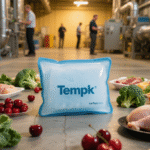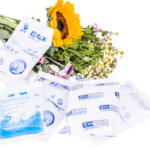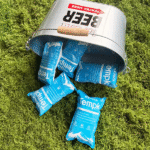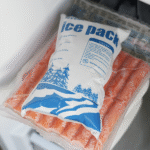Cómo 24 Hour Dry Ice Packs Keep Cold Chain Shipments Frozen for a Day
The world of cold chain logistics relies on dependable refrigeration to keep products safe. 24 paquetes de hielo seco de la hora maintain sub zero temperatures without creating puddles because they sublimate from solid carbon dioxide directly to gas. This guide explains how these ultra cold packs work, how to size them correctly, and what you need to stay compliant in 2025. You’ll learn why they outperform gel packs, how much dry ice you need for a day long journey, and how emerging technologies are making shipping safer and greener.
Como 24 hour dry ice packs work and why are they superior to gel packs?
How do you choose, size and pack 24 hour dry ice packs for different shipments?
What safety and regulatory rules must you follow when using 24 paquetes de hielo seco de la hora?
How can sustainable practices and 2025 innovations improve your cold chain operations?
Cuáles son 24 Hour Dry Ice Packs and How Do They Work?
24 hour dry ice packs consist of pellets or slices of solid carbon dioxide sealed in vented packaging that releases gas as the dry ice warms. Because dry ice sublimates at around –78.5 °C, these packs maintain ultra cold temperatures for 24–72 hours without melting. A diferencia de los paquetes de gel, which thaw at 2–8 °C and leave water behind, dry ice keeps shipments completely frozen and dry. The main keyword appears early to highlight the subject, and understanding sublimation sets the stage for the rest of this article.
Shipping frozen meat, mariscos, vaccines or biologic samples requires reliable cold. Dry ice packs deliver colder temperatures than gel packs because CO₂ absorbs more heat when changing state. Each pack holds pellets that turn into gas, absorbing warmth and keeping your goods at –78.5 °C for up to three days. paquetes de gel, por el contrario, maintain chilled conditions around 2–8 °C. Since dry ice produces no liquid, packages stay dry and there is no condensation or soggy packaging. This makes 24 hour dry ice packs ideal for shipments that must remain completely frozen during transport.
Understanding Sublimation: Why Dry Ice Doesn’t Melt
Dry ice is carbon dioxide in solid form. Instead of melting like water ice, él Susilimaciones – it turns directly into gas. This process occurs at –78.5 °C, which is why dry ice packs are so cold. Sublimation means there is no liquid runoff to damage packaging or leak onto products. Because the gas is heavier than air, you should place dry ice packs above your goods so the cold air can sink and circulate.
| Método de enfriamiento | Rango de temperatura | Duración típica | Lo que significa para ti |
| Mini dry ice sheet | –78.5 °C to –18 °C | 24–48 H | Ideal for pharmaceuticals or biologics that require ultra low temperatures; prevents moisture |
| Disposable dry ice pack | –78.5 °C | Arriba a 72 h | Maintains frozen meats, seafood or vaccines; single use convenience and no melting water |
| Paquete de gel (2–8 ° C) | 2–8 ° C | Arriba a 48 h | Keeps produce or medicines cool without freezing; reusable but may leak |
| Traditional water pack | ≈ 0 °C | 24–36 horas | Cheapest for short journeys; limited thermal mass and produces meltwater |
Practical Tips and Recommendations
Hydrate and freeze properly: Activate dry ice sheets by hydrating the polymer cells and freezing them for at least 24 horas.
Pre chill your products: Freezing or chilling goods before packing reduces the heat load and extends cooling duration.
Use larger sheets for longer trips: Bigger packs contain more CO₂ and last longer.
Coloque paquetes en la parte superior: Fregaderos de aire frío, so position dry ice above your products; para rutas largas, surround goods with packs and combine them with phase change materials (PCM).
Temperatura de monitor: Employ data loggers or IoT sensors to track internal temperatures and adjust the number of packs.
Caso real: A pharmaceutical company shipping 8 lb of frozen vaccine vials from Los Angeles to Chicago used an 8 lb 24 hour dry ice pack and added 30 % extra dry ice for summer conditions. By pre freezing the vials to –20 °C and using vacuum insulated panels, the shipment remained below –70 °C for 72 horas.
Sizing and Packing 24 Paquetes de hielo seco por hora: How Much Do You Need?
The right quantity of 24 hour dry ice packs depends on product weight, tiempo de tránsito, insulation quality and ambient temperature. A simple rule of thumb is a 1:1 ratio of dry ice weight to product weight for 48 hour shipments. For a 24 hour trip, you can often use slightly less, but factors like summer heat or complex routes may require extra packs. For shipments longer than two days, a 1.5:1 ratio is recommended.
Experts also recommend estimating sublimation loss. Dry ice sublimates at a rate of about 5–10 lb per 24 hours in a well insulated container. Mercury, a logistics provider, suggests using 5–10 lb of dry ice per day for items weighing up to 12.5 lb; a two day shipment requires at least 20 lb. Selecting good insulation can extend pack life by reducing sublimation losses.
When calculating your needs, consider route complexity and insulation upgrades. Adding 25–35 % extra dry ice during summer or when delays are expected ensures sufficient cooling. Upgrading to vacuum insulated panels can reduce required dry ice by 10–25 %. Filling void spaces with foam or paper also reduces sublimation. Hybrid packouts combining dry ice with PCMs buffer temperature fluctuations and extend duration beyond 72 horas.
Weight Calculator: How Many Pounds of Dry Ice for 24 Horas?
Use this chart to estimate how much dry ice you need for various payloads and durations. The figures are derived from an industry dry ice calculator and assume good insulation. Values represent total dry ice weight, placed on top of the load; for larger loads the table suggests splitting between top and bottom layers.
| Payload weight (lb) | Dry ice for <12 h (lb) | Dry ice for 24–48 h (lb) | Dry ice for 48–72 h (lb) | Significado práctico |
| 5 | 3 | 5 | 10 | 5 lb payloads need about 5 lb of dry ice for a day; double for longer trips |
| 10 | 5 | 10 | 15 | Usar un 1:1 ratio for up to two days, y 1.5:1 para 72 horas |
| 15 | 8 | 15 | 23 | Add extra for mid size loads; ensure venting when using >20 lb |
| 20 | 10 | 20 | 30 | Larger cargo needs proportionally more dry ice to stay frozen over long distances |
| 30 | 10 (arriba) + 5 (abajo) | 20 (arriba) + 10 (abajo) | 30 (arriba) + 15 (abajo) | Splitting dry ice between top and bottom ensures uniform cooling for heavy shipments |
| 40 | 15 (arriba) + 5 (abajo) | 25 (arriba) + 15 (abajo) | 40 (arriba) + 20 (abajo) | Heavy freight may require up to 40 lb for 72 horas; plan for handling and regulatory limits |
Practical Sizing Tips and Advice
Assess product weight and temperature requirements: Determine whether your goods must stay at –70 °C, –20 °C or 2–8 °C, and adjust dry ice weight accordingly.
Consider route complexity and transit duration: Add 10–15 % more dry ice for multi handoff routes or potential delays.
Upgrade insulation to reduce weight: Vacuum panels or reflective liners can lower dry ice requirements by up to 25 %.
Use hybrid packouts: Combining dry ice with PCMs helps buffer temperature swings and extends cooling to 72 horas o más.
Precondition and pre freeze: Chill products and packaging before assembly to reduce initial heat load.
Real world example: A seafood exporter replaced water ice with small dry ice slices and vented boxes. By matching the dry ice weight to the product weight and filling voids, they reduced shipment weight by 30 % and kept fish fillets frozen for 48 hours without leaks.
Choosing Between 24 Hour Dry Ice Packs and Gel Packs: cual es mejor?
Deciding between 24 hour dry ice packs and gel packs depends on the temperature your product requires and how long it must stay cold. Dry ice packs maintain –78.5 °C and are ideal for frozen goods, while gel packs keep items between 2–8 °C and are best for chilled products. Por ejemplo, frozen meat or vaccines must remain well below zero; chocolates and injectable medicines only need refrigeration..
Gel packs are water based and melt around 0 °C, so they cannot sustain deep freeze conditions. Sin embargo, gel packs protect products that must not freeze. They also help supplement dry ice: combining gel packs and dry ice slows sublimation and extends cooling. When selecting a cooling method, consider product sensitivity, Duración de envío, cost and customer experience. Dry ice is regulated as a hazardous material and requires handling training, while gel packs are unregulated and simpler for end users.
Comparing Dry Ice Packs and Gel Packs: Pros y contras
| Atributo | paquetes de gel | Paquetes de hielo seco | Lo que significa para ti |
| Rango de temperatura | Near 0 °C | Around –78.5 °C | Use gel packs for chilled items and dry ice packs for frozen goods |
| Duración | 12–24 H (standard) | 12–24 h per pack; longer with blocks | Dry ice lasts longer in insulated containers |
| Residuo | Melts to water | Sublimate al gas | Dry ice prevents soggy packages and condensation |
| Manejo | Non hazardous | Requiere guantes y ventilación | Dry ice demands training; gel packs are easier to handle |
| Regulación | Not regulated | Clase 9 Material Peligroso | You must follow packaging, labeling and transport rules for dry ice |
When to Choose Each Cooling Method
Bienes congelados (carne, mariscos, vacunas): Elegir 24 hour dry ice packs to maintain ultra low temperatures. Equal weight of dry ice and product can keep items frozen for up to 48 horas.
Artículos fríos (producir, chocolate, productos farmaceuticos): Use gel packs when you need to keep products between 2–8 °C and prevent freezing.
Mixed shipments (kits de comida): Separate compartments with dry ice for frozen components and gel packs for chilled items.
Customer comfort: If your customers are unfamiliar with dry ice, gel packs may be safer and simpler to dispose of; always include clear instructions when sending dry ice to end users.
Practical scenario: A meal kit company used a hybrid approach—placing dry ice packs around frozen proteins and gel packs beside vegetables. This combination kept all ingredients within their proper temperature ranges and reduced confusion for customers.
Safe Handling and Regulatory Considerations for 24 Paquetes de hielo seco por hora
Dry ice is extremely cold and is classified as a hazardous material (Y 1845), so proper handling is essential. Use guantes aislados, safety goggles and long sleeves to prevent frostbite. Never handle dry ice with bare hands; skin contact can cause severe injury. Because dry ice releases large volumes of CO₂ gas as it sublimates, packages must be vented to prevent pressure buildup and avoid asphyxiation.
Regulatory agencies require that packages containing dry ice display a Class 9 hazard label and indicate the net weight. Many airlines limit dry ice quantities to about 5.5 lb (2.5 kilos) per package and require proper documentation. En los Estados Unidos, shipments over 5.5 lb must comply with Title 49 of the Code of Federal Regulations; international shipments must follow IATA rules. Gel packs are not regulated and require no special labels.
Safety Checklist for 24 Paquetes de hielo seco por hora
| Safety measure | Descripción | Por que importa |
| Wear protective gear | Use thick gloves, goggles and long sleeves | Prevent frostbite and eye injury when handling dry ice |
| Vent containers | Never seal dry ice in an airtight box; use vented lids or punch small holes | Prevents pressure buildup and CO₂ accumulation |
| Etiqueta y documento | Mark packages with UN 1845 labels and net weight | Ensures compliance with shipping regulations |
| Provide instructions | Inform recipients about dry ice handling and disposal | Reduces risk of injury and ensures safe end user experience |
| Respond to frostbite | If contact occurs, remove clothing not frozen to the skin and immerse the area in warm water (abajo 40 °C) | Promotes proper first aid and minimizes damage |
Regulatory Guidance and Weight Limits
Límites de peso: Non medical shipments containing more than 5.5 lb of dry ice must follow Title 49 CFR or IATA rules. Shipments below this threshold require minimal markings.
Documentación: Provide Material Safety Data Sheets (MSDS) or safety instructions to recipients.
Transporte: Ventilate vehicles and avoid carrying dry ice in sealed passenger compartments.
Desecho: Let remaining dry ice sublimate outdoors; never dispose of it in sinks or trash cans where the extreme cold can damage fixtures.
Environmental Impact and Sustainability of 24 Paquetes de hielo seco por hora
Dry ice is essentially recycled CO₂, produced by capturing carbon dioxide from industrial processes such as ammonia synthesis or ethanol production. This means the CO₂ used in dry ice is repurposed rather than newly emitted. Mientras el hielo seco se sublima, it releases CO₂ gas back into the atmosphere, so efficient use reduces the overall footprint.
Sustainability depends on using the right amount and improving insulation. Vacuum insulated panels or reflective liners reduce dry ice consumption, which cuts both cost and CO₂ emissions. Hybrid systems combining dry ice with phase change materials or gel packs extend cooling without increasing CO₂ output. En 2025, reusable dry ice packs are emerging; these can be refilled hundreds of times and reduce waste by 20 %.
Sustainable Best Practices with 24 Paquetes de hielo seco por hora
Source recycled CO₂: Choose dry ice suppliers that produce their product from captured CO₂.
Optimize pack quantity: Use just enough dry ice by calculating your needs and upgrading insulation.
Combine cooling methods: Hybrid packouts reduce the amount of dry ice required and lower emissions.
Consider reusable packs: Emerging reusable dry ice packs can be replenished, saving money and reducing waste.
Educate customers: Provide clear disposal instructions so recipients let dry ice sublimate outdoors rather than in enclosed spaces.
| Sustainability measure | Descripción | Beneficio |
| Recycled CO₂ production | Dry ice made from CO₂ captured from industrial processes | Reduces reliance on virgin fossil fuels |
| Actualizaciones de aislamiento | Vacuum panels, reflective liners or foam fillers | Lower dry ice consumption and CO₂ release |
| Sistemas de enfriamiento híbrido | Combining dry ice packs with PCMs or gel packs | Extends cooling duration without adding more dry ice |
| Paquetes de hielo secos reutilizables | Packs designed to be refilled and reused hundreds of times | Cuts waste and long term costs by up to 20 % |
2025 Tendencias: Innovations in 24 Paquetes de hielo seco por hora
La industria de la cadena de frío está evolucionando rápidamente. En 2025, 24 hour dry ice packs are benefitting from smart sensors, blockchain traceability and greener materials. IoT temperature loggers and cloud based monitoring allow shippers to track the internal temperature of packages in real time and receive alerts if temperatures rise. Blockchain systems ensure chain of custody documentation, enhancing transparency and compliance. Reusable dry ice packs and hybrid cooling systems are becoming mainstream, Reducción de los desechos y costos.
Latest Progress Overview
Monitoreo inteligente: Data loggers integrated with 24 hour dry ice packs transmit temperature and location data, enabling proactive interventions when deviations occur.
Paquetes reutilizables: Innovations in materials allow dry ice packs to be refilled dozens or even hundreds of times, cutting per shipment cost and lowering CO₂ emissions.
Hybrid solutions: Combining dry ice with phase change materials (PCM) and gel packs creates multi temperature compartments in a single shipment.
Blockchain tracking: Digital ledgers record every handoff, ensuring regulatory compliance and preventing tampering. This builds trust in the cold chain.
Sustainable production: Manufacturers increasingly produce dry ice from captured CO₂ and adopt biodegradable packaging to reduce environmental impact.
Ideas del mercado
The global cold chain refrigerants market is projected to grow from about US$1.69 billion in 2025 to US$2.92 billion by 2032. This growth reflects rising demand for temperature controlled logistics across food, pharmaceuticals and biotech. Dry ice remains a critical refrigerant because it provides ultra cold conditions that gel packs cannot achieve. Mientras tanto, the broader cold chain market could exceed US$1.6 trillion by 2033. Investing in sustainable and smart 24 hour dry ice pack solutions positions you to benefit from this expanding market.
Preguntas frecuentes
How long do 24 hour dry ice packs last?
24 hour dry ice packs are designed to keep products frozen for at least a full day. In a well insulated container, dry ice sublimates at about 5–10 lb per 24 horas. Larger packs or blocks can maintain ultra cold temperatures for up to 72 horas.
How much dry ice should I use for a 24 hour shipment?
Use roughly equal weight of dry ice to product weight for shipments under 48 horas. Por ejemplo, a 10 lb payload typically requires 5–10 lb of dry ice for one day. Adjust for ambient temperature and insulation quality.
Son 24 hour dry ice packs safe to use?
Sí, when handled properly. Always wear insulated gloves and safety goggles, keep packages vented and label them with UN 1845 hazard warnings. Follow weight limits to comply with regulations.
Can I reuse a 24 hour dry ice pack?
Traditional disposable packs are single use. Sin embargo, reusable dry ice packs are emerging in 2025 that can be refilled hundreds of times, saving money and reducing waste.
What is the difference between dry ice and gel packs for overnight shipping?
Dry ice maintains –78.5 °C and keeps products frozen, while gel packs maintain 2–8 °C for chilled goods. Dry ice is regulated as a hazardous material and requires venting and labeling; gel packs are non hazardous and easier to handle.
Resumen y recomendaciones
In this guide you learned that 24 paquetes de hielo seco de la hora work by sublimating solid carbon dioxide, providing ultra cold temperatures without messy meltwater. You discovered that sizing these packs depends on product weight, transit duration and insulation, con un 1:1 dry ice to payload ratio serving as a starting point. You compared dry ice packs to gel packs, seeing that dry ice is best for frozen goods while gel packs suit chilled items. Safety guidelines remind you to wear protective gear, vent containers and comply with regulations. Sustainability initiatives, such as using recycled CO₂ and hybrid cooling systems, Reducir el impacto ambiental.
Próximos pasos viables
Calculate your needs: Use the weight chart to estimate how many 24 hour dry ice packs you need for your next shipment. Factor in product weight, transit time and ambient temperature.
Actualizar aislamiento: Evaluate whether vacuum insulated panels or reflective liners can reduce dry ice consumption by up to 25 %.
Entrena a tu equipo: Educate staff on safe handling, labeling and disposal of dry ice to prevent accidents and ensure compliance.
Explore reusable options: Investigate reusable dry ice packs and hybrid packouts to lower costs and improve sustainability.
Monitor shipments: Implement IoT sensors or data loggers to track temperature and receive alerts when intervention is needed.
Acerca de Tempk
Tempk se especializa en innovative cold chain packaging. We design and manufacture 24 paquetes de hielo seco de la hora, paquetes de gel, insulated bags and high performance box liners. Our products leverage recycled CO₂ and advanced insulation to provide reliable, eco friendly cooling. With decades of experience and an R&D center focused on sustainable materials, we help customers ship perishable goods safely while reducing waste and cost. Eligiendo tempk, you gain access to customized solutions, technical support and the latest cold chain innovations.
Llamado a la acción
Listo para optimizar su cadena fría? Contact Tempk today for a personalized consultation or explore our range of dry ice packs and insulated packaging solutions. Our team will help you choose the right products, calculate your dry ice needs and implement sustainable practices.























